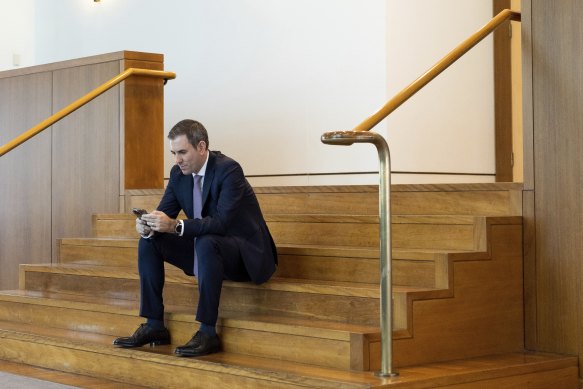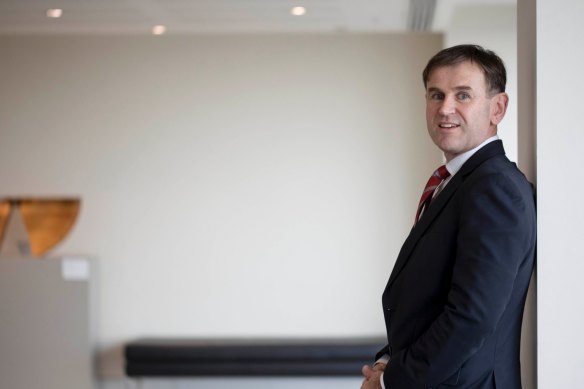Key points
- Expected GDP growth 1.5 percent in 2023-24 (a percentage point down on what was expected in the March budget).
- $10 billion will be cut from spending and another $11 billion in spending will be adjusted – such as delays beyond the forward estimates – over the next four years.
- Of that, $6.5 billion will be the delay of infrastructure projects, while $2 billion will be cut from various grants programs.
- Welfare spending will grow by $33 billion over the budget cycle.
- Treasurer Jim Chalmers says wage growth will outstrip inflation some time the year after next.
Treasurer Jim Chalmers will reveal a full percentage point downgrade in Australia’s economic outlook in Tuesday’s federal budget with warnings he needs to cut spending much more aggressively to make the nation’s finances sustainable.
Chalmers will release forecasts showing GDP growth in 2023-24 at 1.5 per cent, a full percentage point down on what was expected in the March budget, after a downwardly revised 3.25 per cent growth rate this financial year, a quarter percentage point lower than predicted.
Treasurer Jim Chalmers will reveal a sharp downgrade to expected economic growth in Tuesday’s budget.Credit:Alex Ellinghausen
A combination of the Reserve Bank’s aggressive increase in interest rates and global economic turbulence is behind the bleaker outlook for growth, which would be accompanied by higher-than-expected inflation over the next two years.
Chalmers, who on Tuesday will deliver the first budget by a Labor treasurer since 2013, said the economic outlook around the world was deteriorating.
“While we have plenty of things going for us, Australians have not been immune from rampant global inflation, heightened uncertainty and cost of living pressures here at home,” he said.
“These headwinds will inevitably impact our growth outlook and Australians are already feeling the pinch from higher prices and rising interest rates.”
The government will reveal about $10 billion in spending cuts and another $11 billion in adjusted spending – such as delays beyond the forward estimates – to show a boost to the bottom line over the next four years.
The savings and “reprofiled” spending will include $6.5 billion in delays to infrastructure projects and $2 billion in cuts from a range of grants programs.
The savings are the first to be identified by the government’s audit of spending, headed by Finance Minister Katy Gallagher, with more programs to be sliced in coming months.
Shadow treasurer Angus Taylor said if Chalmers and the government used the budget to lift economic growth and contain spending then the opposition was prepared to support him.
“Australians need Jim Chalmers to stop complaining about the challenges of this economy and instead deliver a plan to support Australians through this cost of living crisis,” he said.
“If the treasurer can deliver on these priorities, we will back him in. If not, we will hold him to account.”
While Labor went to the election with a promise to get wages moving, Chalmers indicated on Sunday he did not expect wages to rise in real terms until some time in 2024.
“Real wages were falling before the election, and they’ve been falling since the election. That’s because inflation is higher for longer,” he told the ABC.
“Wages growth, which is beginning to happen in our economy, will cross over with inflation some time, we think, the year after next.”
Respected economist Stephen Anthony, managing director of Macroeconomics Advisory, will on Monday release research showing the government has to cut much deeper if it is to put the budget on a sustainable footing.
Chalmers is expected to show a drop in the forecast deficits for the current year and 2023-24 but an increase in years further out due to spending pressures and a drop-off in commodity prices and tax collections.
Anthony said commodity prices were delivering a $55 billion a year windfall to the budget over the forward estimates, out to 2025-26.
Economist Stephen Anthony says the budget will remain in structural deficit for decades without a proper approach to spending restraint.Credit:Arsineh Houspian
He said this revenue was masking the true state of the budget, which was in structural deficit, around 2 per cent of GDP or more than $40 billion a year. That would widen without a cut in spending of the scale that former treasurers Paul Keating and Peter Costello delivered in their early budgets.
“Unfortunately, instead of banking windfalls revenues since early 2021, the federal government has continued to spend the proceeds of pandemic recovery via a pro-cyclical expansion. All of this is making the Reserve Bank governor’s job of curtailing inflationary expectations that much harder,” he said.
“Our assessment is that persistent and ongoing structural deficits will widen into next decade and see the federal government nearly double its debt to GDP burden based on rising real interest costs.”
Some of those spending pressures were identified by Chalmers on Sunday, who said welfare spending would grow by $33 billion over the budget cycle due to higher pension and social service payments that are indexed to inflation.
EY chief economist Cherelle Murphy says a proper reform agenda needs to be put in place to repair the budget.
Spending on the NDIS, aged care, the health system, defence and interest on government debt are all adding to the pressures on the budget which was forecast in March to show a deficit of $78 billion in 2022-23.
Chief economist with EY, Cherelle Murphy, also expects a structural budget deficit over the next decade.
In research to be released on Monday, Murphy estimates the structural deficit will gradually fall from around 2 per cent of GDP to one per cent of GDP by 2032-33.
She said the government has to rein in spending while also embarking on productivity-enhancing reforms, including in tax, that helped the economy to grow faster.
“The challenge that Australia faces is that we don’t just need a bread and butter budget. We need a bread and butter treasurer firstly focused on reining in spending. Through this bread and butter approach, the treasurer can let the private sector lead growth which then provides space to invest in productivity measures to grow the capacity of the economy,” she said.
Cut through the noise of federal politics with news, views and expert analysis from Jacqueline Maley. Subscribers can sign up to our weekly Inside Politics newsletter here.
Most Viewed in Politics
From our partners
Source: Read Full Article



